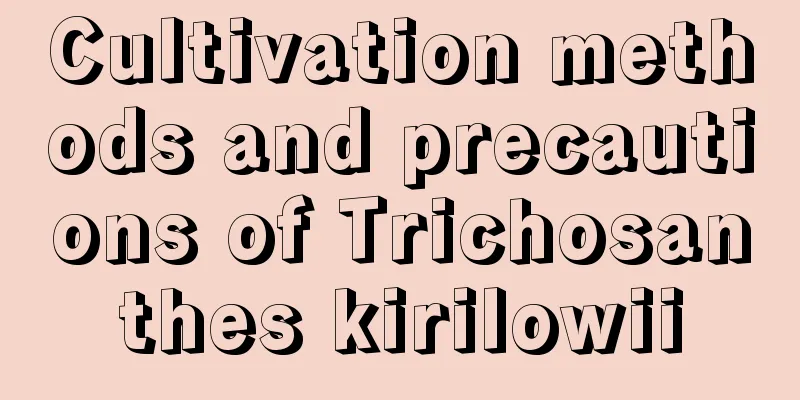Cultivation methods and precautions of Trichosanthes kirilowii

1. Maintenance methods1. Soil: Trichosanthes kirilowii does not have high requirements for the soil, as long as the soil is fertile and has good drainage. Before planting, you need to mix base fertilizer into the soil, because the newly planted plants have a relatively large demand for nutrients, and the nutrients in the soil alone are not enough. 2. Watering: Plants planted in the open field generally do not need watering as long as the climate is normal. However, if the drought lasts for more than one month, the plants need to be watered, otherwise the growth of the plants will be affected. The best watering frequency is once a week. 3. Fertilization: In addition to the fertilizer applied before planting, top dressing is also required during the growth period. You can use fertilizers with milder effects, or you can use compound fertilizers, because compound fertilizers have more comprehensive nutrients and can meet the various needs of plants. After fertilizing, you need to water it to allow the fertilizer to fully dissolve into the soil and facilitate plant absorption. 4. Light: The growth of plants cannot be separated from sunlight. Insufficient light will affect the yield of plants. If conditions permit, it can receive full-day sunlight. If not, the minimum daily sunlight time should reach five hours. 2. Breeding techniques1. Reproduction: Trichosanthes can be propagated by sowing. Generally, we choose fruits that mature in September and October and store them. In March and April of the following year, we soak the seeds in warm water for a day and a night, and then use wet sand to germinate them. The sowing method is hole planting, with each hole two meters apart. After sowing, we cover them with soil, and seedlings will generally emerge in half a month. 2. Loosen the soil: About half a month after planting, you need to dig up the soil pile to check. If the middle roots have sprouted and the soil is moist, you can flatten the soil pile to facilitate the emergence of the seedlings. 3. Problem Diagnosis1. Pests: It is susceptible to melon borer, whose larvae will eat the melon leaf pulp and spread diseases. To treat melon borer, you can use Greengard solution spray. 2. Diseases: It is susceptible to anthracnose, which usually occurs in the seedling stage and can harm the seedlings of the plant. In severe cases, it can affect the yield. Anthracnose can be treated by spraying wettable powder of carbendazim. IV. Other issues1. Edible: edible. 2. Toxicity: Non-toxic and can be used as medicine. |
<<: Cultivation methods and precautions of ground radish
>>: Red pepper cultivation methods and precautions
Recommend
Growth habits of tuberose
Growth environment Tuberose prefers a warm, humid...
How to grow Jasmine multiflora
1. Soil It is best to choose sandy loam rich in h...
How to grow geraniums
1. Soil It is best to use fertile, loose soil to ...
Don’t throw away watermelon rinds, use them to make fertilizer, it’s useful and costs no money!
Step 1 Pick a large watermelon and eat all the fl...
When is the best time to sow delphiniums?
Delphinium sowing time Delphinium is a plant of t...
How to deal with lilies after they bloom
1. Pruning After the lilies have finished bloomin...
Why do the leaves of the money tree become soft? Let me teach you a trick to revive it!
1. Reasons 1. Sunlight: It likes light, but can t...
How to propagate mountain roses and what to pay attention to
Mountain rose propagation method The main methods...
How to grow strawberries
1. Adequate lighting When planting strawberries, ...
Put a fish in the hydroponic bottle, the roots will be fertile, the leaves will be green and insects will not be attracted!
Why do hydroponics breed insects? Water sources a...
How often should I water the Kalanchoe in summer?
How often should Kalanchoe be watered in summer? ...
The flower language and symbolic meaning of Cymbidium
The Flower Language of Cymbidium The most common ...
What month is suitable for planting cucumbers? What season is best for planting cucumbers?
When to plant cucumbers Cucumbers are generally p...
The cutting method and precautions of Pentaphyllum truncatum. Which month is suitable for cutting?
The most common way of propagation of Pentaphyllu...
Planting technology and cultivation management of Asparagus cochinchinensis
Asparagus cochinchinensis may be an unfamiliar na...









